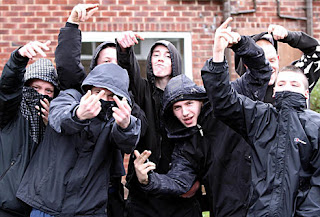The collective our example illustrates is the British youth. We will be representing male and female teenagers across Britain as this gives the our audience a balanced perspective of how both genders are portrayed to society. By using this collective we can find examples from the media and footage from television programs easily because we would be able to relate well to the issues relating to our collective that are being displayed.
The representation of our collective group, British teenagers, has become a more negatively displayed representation throughout the media. We will be trying to demonstrate examples which clearly present this view, for example when the events of the riots were happening in cities of high population , the younger teens were the main focus of the newspapers. This was because it is more shocking to see teenagers of a younger age to be looting and committing non utilitarian crime and therefore makes a more interesting read for the newspaper's readers. This clearly is portraying teenagers in a negative light , and it demonstrates to the reader how society has this negative stereotype of teenagers in the present day because footage and recordings of a teenager helping an elderly lady over the road wouldn't be displayed on the front page of a popular newspaper. This suggests that we could argue the view of teenagers has changed over time possibly due to the way the media portrays our collective because the media influence a lot of the norms and values society excepts and learns from the papers.
Although the media can often display our collective negatively this can be an advantage for such institutions as the press and television because it can provide them with continuous interesting evidence or footage to use and adapt to display interesting messages and entertainment to what the audience or reader would be interested in. For instance the program Misfits sets up the entire setting of its series in a community service building for the characters. This indicates to the audience that the teenagers, our collective, have clearly done something wrong and deserve to be there, however it provides great entertainment for the audience at home as it is a unique setting but it does continue to display this negative stereotype of teenagers.
Another advantage of displaying the collective in this way is that from my perspective, the perspective of a young teenager, is that the negative judgement people within society can have of us can produce social change. For instance the government reconsiders the options to help get youths off of the streets , such as an increase in youth centers has dramatically risen in the last ten years.
A disadvantage of representing the collective in this way is that it can lead to people in society continuously having a negative stereotype of any individual teenager they meet. In addition to this negative displays of the collective within the media can lead to certain types of teenagers being specifically judged, for example if you are a certain race or are of a lower class they are more likely to be stigmatized by the public because they will be reflecting the stigma the media has attached to British teenagers.
The collective we are researching could be argued to having the most likely ability to convert the stigma that is attached to them by the media because they are the younger generation with a big future ahead of them. For instance many people would argue that young teenagers in Britain are offered an equal chance to gain high education and to establish themselves well within the economic society. People within society could also argue that young teenagers within Britain have many different clubs which they could attend to discover or build a talent within a sport etc. For instance Tom Bailey , the young diver from Plymouth, that aims to be held in the 2012 Olympics can display a good example of how young teenagers in Britain can produce an identity for themselves. However some people within society could claim that institutions such as education which are meant to provide the same equal opportunity for anyone, i.e. any class, any gender, any race etc don't always provide the right support for those who need it to gain the equal opportunity of success for their identity. For instance children from working class backgrounds may , without knowing, be labelled by teachers as low achievers within the school and therefore not be able to achieve similar success to middle class children. In addition to this these working class children may not be able to afford the necessary resources which would help them achieve their path to success through education. However the labour government did introduce facilities such as EMA to help those children who needed extra financial support with education resources to get it. Financial fundings for clubs and education etc are what a lot of people within our collective rely on to be able to reach or achieve their identity. However social change often means fundings which are provided by the government to help our collective are abolished , such as the decrease in payment for EMA since the coalition of the new government has happened.



No comments:
Post a Comment